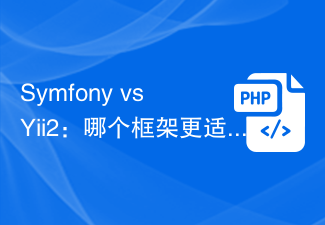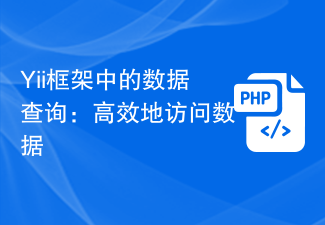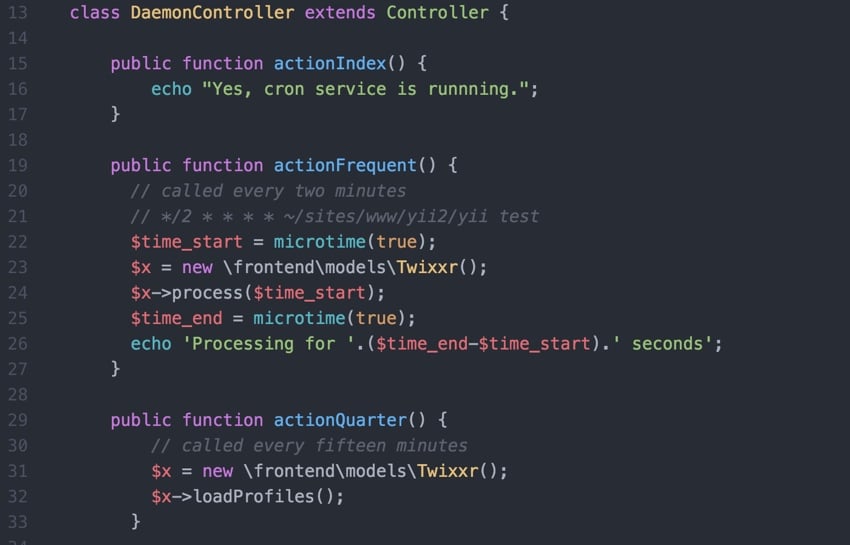這篇文章主要介紹了Yii基於數組和對象的Model查詢技巧,結合實例形式較為詳細的分析了Yii針對數組及對象的Model查詢使用技巧,需要的朋友可以參考下
#本文實例講述了Yii基於陣列和物件的Model查詢技巧。分享給大家供大家參考,具體如下:
對於一個Model Post 有如下的4中查詢方法,傳回物件或物件陣列。
//查找满足指定条件的结果中的第一行 find the first row satisfying the specified condition $post=Post::model()->find($condition,$params); //查找具有指定主键值的那一行 find the row with the specified primary key $post=Post::model()->findByPk($postID,$condition,$params); //查找具有指定属性值的行 find the row with the specified attribute values $post=Post::model()->findByAttributes($attributes,$condition,$params);//未找到返回null //通过指定的SQL 语句查找结果中的第一行 find the first row using the specified SQL statement $post=Post::model()->findBySql($sql,$params);
如果find 方法找到了一個滿足查詢條件的行,它將傳回一個Post 實例,實例的屬性含有資料表行中對應列的值。然後我們就可以像讀取普通物件的屬性一樣讀取載入的值,例如echo $post->title;。如果使用給定的查詢條件在資料庫中沒有找到任何東西, find 方法將傳回null。
呼叫find 時,我們使用$condition 和$params 指定查詢條件。此處$condition 可以是SQL 語句中的WHERE 字串,$params 則是一個參數數組,其中的值應綁定到$condation 中的佔位符。例如:假設我們查詢postID = 10的資料
// find the row with postID=10 $post=Post::model()->find('postID=:postID', array(':postID'=>10));
條件$condition 就是我們sql裡的where部分,那參數怎麼辦呢,透過params傳遞,不過名字是加了":"的。
YII有個CDbCriteria類別可以建構查詢,如果我們查詢postId為10的title,CdbCriteria是這樣建構的
$criteria=new CDbCriteria; $criteria->select='title'; // only select the 'title' column $criteria->condition='postID=:postID'; $criteria->params=array(':postID'=>10); $post=Post::model()->find($criteria); // $params is not needed
一種替代CDbCriteria 的方法是給find 方法傳遞一個陣列。陣列的鍵和值各自對應標準( criterion)的屬性名稱和值,上面的範例可以重寫為如下:
$post=Post::model()->find(array( 'select'=>'title', 'condition'=>'postID=:postID', 'params'=>array(':postID'=>10), ));
當然也適用於findAll()
self::$_items[$type]=array(); $models=self::model()->findAll(array( 'condition'=>'type=:type', 'params'=>array(':type'=>$type), 'order'=>'position', ));
當一個查詢條件是關於按指定的值來匹配幾個列時,我們可以使用findByAttributes()。我們讓$attributes 參數是一個以列名做索引的值的陣列。
findByAttributes 裡的$attributes就是字段的名字.查詢title為abc怎麼查詢呢?請看下面
Post::model()->findByAttributes(array('title'=>'abc'))
其它方法:
#1、$admin=Admin::model()->findAll($condition,$params);
該方法是根據一個條件來查詢一個集合,如:
findAll("username=:name",array(":name"=>$username));#2、$admin=Admin::model()->findAllByPk($postIDs, $condition,$params);
findAllByPk($id,"name like ':name' and age=:age" ,array(':name'=>$name,'age'=> $age));
此方法是根據主鍵查詢一個集合,可以使用多個主鍵,如:
findAllByPk(array(1,2));
3、$admin=Admin::model()->findAllByAttributes ($attributes,$condition,$params);
該方法是根據條件查詢一個集合,可以是多個條件,把條件放到數組裡面,如:
findAllByAttributes(array('username'=>'admin'));
4、$admin=Admin::model()->findAllBySql($sql,$params);
此方法是根據SQL語句查詢一個陣列,如:
findAllBySql("select *from admin where username=:name",array(':name'=>'admin'));二、查詢物件的方法
1、$admin=Admin::model()->findByPk($postID,$condition,$ params);
根據主鍵查詢出一個物件,如:
findByPk(1);
2、$row=Admin::model()->find($condition, $params);
根據一個條件查詢出一組數據,可能是多個,但是他只返回第一行數據,如:
find('username=:name',array(':name'=>'admin'));
#3、 $admin=Admin::model()->findByAttributes($attributes,$condition,$params);
該方法是根據條件查詢一組數據,可以是多個條件,把條件放到數組裡面,他查詢的也是第一個數據,如:
findByAttributes(array('username'=>'admin'));
4、$admin=Admin::model()->findBySql($sql,$params);
該方法是根據SQL語句查詢一組數據,他查詢的也是第一條數據,如:
findBySql("select *from admin where username=:name",array(':name'=>'admin'));5、拼一個獲得SQL的方法,在根據find查詢出一個物件
$criteria=new CDbCriteria; $criteria->select='username'; // only select the 'title' column $criteria->condition='username=:username'; $criteria->params=array(':username=>'admin'); $post=Post::model()->find($criteria); // $params is not needed
三、查詢個數,判斷查詢是否有結果
1、$n=Post: :model()->count($condition,$params);
此方法是根據一個條件查詢一個集合有多少筆記錄,傳回一個int型數字,如
count("username=:name",array(":name"=>$username)); 2、$n=Post::model()->countBySql($sql,$params);
此方法是根據SQL語句查詢一個集合有多少條記錄,傳回一個int型數字,如
countBySql("select *from admin where username=:name",array(':name'=>'admin'));3、$exists=Post::model()->exists($condition,$params);
#該方法是根據一個條件查詢查詢得到的數組有沒有數據,如果有數據回傳一個true,否則沒有找到
四、添加的方法
$admin=new Admin;
$admin->username=$username;
$admin->password=$password;
if($admin->save()>0){
echo "添加成功";
}else{
echo "添加失败";
}五、修改的方法
1、Post::model()->updateAll($attributes,$condition,$params);
#$count = Admin::model()->updateAll(array('username'=>'11111','password'=>'11111'),'password=:pass',array(':pass'=>'1111a1'));
if($count>0){
echo "修改成功";
}else{
echo "修改失败";
}2、Post::model()->updateByPk($pk,$attributes,$condition,$params);
#$count = Admin::model()->updateByPk(1,array('username'=>'admin','password'=>'admin'));
$count = Admin::model()->updateByPk(array(1,2),array('username'=>'admin','password'=>'admin'),'username=:name',array(':name'=>'admin'));
if($count>0){
echo "修改成功";
}else{
echo "修改失败";
}$pk代表主键,可以是一个也可以是一个集合,$attributes代表是要修改的字段的集合,$condition代表条件,$params传入的值
3、Post::model()->updateCounters($counters,$condition,$params);
$count =Admin::model()->updateCounters(array('status'=>1),'username=:name',array(':name'=>'admin'));
if($count>0){
echo "修改成功";
}else{
echo "修改失败";
}array('status'=>1)代表数据库中的admin表根据条件username='admin',查询出的所有结果status字段都自加1
六、删除的方法
1、Post::model()->deleteAll($condition,$params);
$count = Admin::model()->deleteAll('username=:name and password=:pass',array(':name'=>'admin',':pass'=>'admin'));
$id=1,2,3
deleteAll('id in(".$id.")');删除id为这些的数据
if($count>0){
echo "删除成功";
}else{
echo "删除失败";
}2、Post::model()->deleteByPk($pk,$condition,$params);
$count = Admin::model()->deleteByPk(1);
$count = Admin::model()->deleteByPk(array(1,2),'username=:name',array(':name'=>'admin'));
if($count>0){
echo "删除成功";
}else{
echo "删除失败";
}以上就是本文的全部内容,希望对大家的学习有所帮助,更多相关内容请关注PHP中文网!
相关推荐:
关于Yii Framework框架获取分类下面的所有子类的方法
以上是關於Yii基於數組和物件的Model查詢的詳細內容。更多資訊請關注PHP中文網其他相關文章!
 如何使用PHP框架Yii开发一个高可用的云备份系统Jun 27, 2023 am 09:04 AM
如何使用PHP框架Yii开发一个高可用的云备份系统Jun 27, 2023 am 09:04 AM随着云计算技术的不断发展,数据的备份已经成为了每个企业必须要做的事情。在这样的背景下,开发一款高可用的云备份系统尤为重要。而PHP框架Yii是一款功能强大的框架,可以帮助开发者快速构建高性能的Web应用程序。下面将介绍如何使用Yii框架开发一款高可用的云备份系统。设计数据库模型在Yii框架中,数据库模型是非常重要的一部分。因为数据备份系统需要用到很多的表和关
 Yii2 vs Phalcon:哪个框架更适合开发显卡渲染应用?Jun 19, 2023 am 08:09 AM
Yii2 vs Phalcon:哪个框架更适合开发显卡渲染应用?Jun 19, 2023 am 08:09 AM在当前信息时代,大数据、人工智能、云计算等技术已经成为了各大企业关注的热点。在这些技术中,显卡渲染技术作为一种高性能图形处理技术,受到了越来越多的关注。显卡渲染技术被广泛应用于游戏开发、影视特效、工程建模等领域。而对于开发者来说,选择一个适合自己项目的框架,是一个非常重要的决策。在当前的语言中,PHP是一种颇具活力的语言,一些优秀的PHP框架如Yii2、Ph
 php如何使用Yii3框架?May 31, 2023 pm 10:42 PM
php如何使用Yii3框架?May 31, 2023 pm 10:42 PM随着互联网的不断发展,Web应用程序开发的需求也越来越高。对于开发人员而言,开发应用程序需要一个稳定、高效、强大的框架,这样可以提高开发效率。Yii是一款领先的高性能PHP框架,它提供了丰富的特性和良好的性能。Yii3是Yii框架的下一代版本,它在Yii2的基础上进一步优化了性能和代码质量。在这篇文章中,我们将介绍如何使用Yii3框架来开发PHP应用程序。
 Symfony vs Yii2:哪个框架更适合开发大型Web应用?Jun 19, 2023 am 10:57 AM
Symfony vs Yii2:哪个框架更适合开发大型Web应用?Jun 19, 2023 am 10:57 AM随着Web应用需求的不断增长,开发者们在选择开发框架方面也越来越有选择的余地。Symfony和Yii2是两个备受欢迎的PHP框架,它们都具有强大的功能和性能,但在面对需要开发大型Web应用时,哪个框架更适合呢?接下来我们将对Symphony和Yii2进行比较分析,以帮助你更好地进行选择。基本概述Symphony是一个由PHP编写的开源Web应用框架,它是建立
 Yii框架中的数据查询:高效地访问数据Jun 21, 2023 am 11:22 AM
Yii框架中的数据查询:高效地访问数据Jun 21, 2023 am 11:22 AMYii框架是一个开源的PHPWeb应用程序框架,提供了众多的工具和组件,简化了Web应用程序开发的流程,其中数据查询是其中一个重要的组件之一。在Yii框架中,我们可以使用类似SQL的语法来访问数据库,从而高效地查询和操作数据。Yii框架的查询构建器主要包括以下几种类型:ActiveRecord查询、QueryBuilder查询、命令查询和原始SQL查询
 yii如何将对象转化为数组或直接输出为json格式Jan 08, 2021 am 10:13 AM
yii如何将对象转化为数组或直接输出为json格式Jan 08, 2021 am 10:13 AMyii框架:本文为大家介绍了yii将对象转化为数组或直接输出为json格式的方法,具有一定的参考价值,希望能够帮助到大家。
 Yii2编程指南:运行Cron服务的方法Sep 01, 2023 pm 11:21 PM
Yii2编程指南:运行Cron服务的方法Sep 01, 2023 pm 11:21 PM如果您问“Yii是什么?”查看我之前的教程:Yii框架简介,其中回顾了Yii的优点,并概述了2014年10月发布的Yii2.0的新增功能。嗯>在这个使用Yii2编程系列中,我将指导读者使用Yii2PHP框架。在今天的教程中,我将与您分享如何利用Yii的控制台功能来运行cron作业。过去,我在cron作业中使用了wget—可通过Web访问的URL来运行我的后台任务。这引发了安全问题并存在一些性能问题。虽然我在我们的启动系列安全性专题中讨论了一些减轻风险的方法,但我曾希望过渡到控制台驱动的命令
 PHP开发:使用 Yii2 和 GrapeJS 实现后台 CMS 和 前端可视化编辑Jun 15, 2023 pm 11:48 PM
PHP开发:使用 Yii2 和 GrapeJS 实现后台 CMS 和 前端可视化编辑Jun 15, 2023 pm 11:48 PM在现代软件开发中,构建一个强大的内容管理系统(CMS)并不是一项容易的任务。不仅需要开发人员具备丰富的技能以及经验,还需要使用最先进的技术和工具来使其功能与性能达到最优化。本文介绍了如何使用Yii2和GrapeJS,两个流行的开源软件来实现后台CMS和前端可视化编辑。Yii2是一个流行的PHPWeb框架,它提供了丰富的工具和组件来快速构


熱AI工具

Undresser.AI Undress
人工智慧驅動的應用程序,用於創建逼真的裸體照片

AI Clothes Remover
用於從照片中去除衣服的線上人工智慧工具。

Undress AI Tool
免費脫衣圖片

Clothoff.io
AI脫衣器

AI Hentai Generator
免費產生 AI 無盡。

熱門文章

熱工具

MantisBT
Mantis是一個易於部署的基於Web的缺陷追蹤工具,用於幫助產品缺陷追蹤。它需要PHP、MySQL和一個Web伺服器。請查看我們的演示和託管服務。

MinGW - Minimalist GNU for Windows
這個專案正在遷移到osdn.net/projects/mingw的過程中,你可以繼續在那裡關注我們。 MinGW:GNU編譯器集合(GCC)的本機Windows移植版本,可自由分發的導入函式庫和用於建置本機Windows應用程式的頭檔;包括對MSVC執行時間的擴展,以支援C99功能。 MinGW的所有軟體都可以在64位元Windows平台上運作。

SublimeText3 Mac版
神級程式碼編輯軟體(SublimeText3)

SublimeText3 英文版
推薦:為Win版本,支援程式碼提示!

禪工作室 13.0.1
強大的PHP整合開發環境





